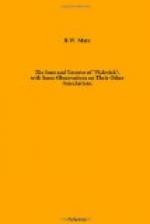The inn is just an inn; a commodious village ale-house; that is the best description of it. Its picturesque exterior, with its hanging sign bearing a portrait of Mr. Pickwick in the act of addressing the club, and the legend, “Dickens’s Old Pickwick Leather Bottle,” and its red-tiled roof, its small windows with their old-fashioned shutters, is no less quaint and attractive than its old-time interior. Its original sign—the Leather Bottle—hangs in the tiny bar which is on the immediate right of the passage, and behind a glass window, looking as unlike a bar as anything imaginable. From this curious little receptacle refreshment for travellers and villagers is dispensed in stone mugs embellished with the sign of the inn; and its “low-roofed room” is at the end of the passage as Mr. Pickwick found it, with its oak beams across the ceiling adding to its picturesqueness. In this room the “high back leather-cushioned chairs” are still to be seen, together with a grandfather clock and other antique pieces of furniture in thorough keeping with tradition.
There, too, is the great “variety of old portraits” which decorated the wall in Mr. Pickwick’s time, with every other available inch of wall space now covered with portraits of the novelist and his memorable characters, pictures of scenes from his books, Dickensian relics and knicknacks, either associated with the book which brought it fame or with other books of the famous Boz. In a word, it is a veritable Dickens museum, in which every lover of the novelist lingers with pleasure and amazement, oblivious of the fact that possibly his tea is getting cold.
Here the visitor can have his meal as did Mr. Tupman, not perhaps in such solitude, for the “Leather Bottle” to-day is often a busy centre for pedestrians from the neighbouring villages, and cyclists and motorists from far-distant towns and cities.
Upstairs, overlooking the churchyard, is the identical front bedroom where Mr. Pickwick spent the night, and where he sat reading long into the early and eerie hours of the morning. The present landlord is a true Dickensian in knowledge and character, and endeavours to make everybody comfortable and welcome, no matter who he be. A glance at the visitors’ book will show how the inn has been sought out by every grade of society from all over the world. Indeed, we doubt if Shakespeare’s birthplace can surpass this inn in popularity.
[illustration: The Coffee Room, “Leather Bottle,” Cobham, Kent. From a photograph]
But it is not merely a Pickwickian inn. It is a Dickensian inn for which the novelist himself had a warm place in his heart for its own sake, spending many pleasant hours within its comfortable walls. Long before he came to live at Gad’s Hill, close by, he loved the place. As a boy at Chatham, probably he walked over in company with his father; and when spending his honeymoon at Chalk, he no doubt roamed in the beautiful lanes around the village. In 1840, after spending a vacation at Broadstairs, he posted back to London with Maclise and Forster by way of Chatham, Rochester and Cobham, and the three spent two agreeable days in revisiting well-remembered scenes.




